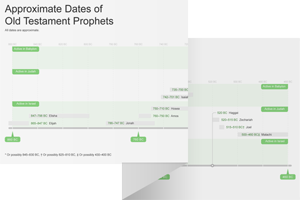1:1 Nothing is known about the prophet Joel |
The word of Yahweh A common introductory phrase (see Hos 1:1 and note).
 Prophetic Commissioning and the Divine Presence
Prophetic Commissioning and the Divine Presence
Joel son of Pethuel His name means “Yahweh is God.” The meaning of his father’s name is uncertain, perhaps “young man of God.”
1:2–20 Joel opens by calling the people to realize that the national calamity upon them—an invasion of locusts—is a precursor of the military invasion they can expect as judgment unless they repent. The first section describes the coming locust invasion. It ends with a call for repentance that links the locust disaster to the coming Day of Yahweh. |
1:2 Hear this, O elders A standard phrase prophets used to call their audiences to attention (compare Hos 4:1).
elders Chief leaders of the people. See note on Jer 26:17.
in your days? Or the days of your ancestors Evokes the imagery of the plague of locusts on Egypt (see Exod 10:6).
1:4 the cutting locust Joel used four different words for “locust” to emphasize the extreme nature of the ecological disaster. Locusts came in swarms, consuming all plant growth (see Exod 10:4–6). The locust swarm was part of the curse for breaking the covenant (see Deut 28:38).
1:5 it is cut off from your mouth The devastation of the vineyards will mean no more wine for the drunkards.
1:6 a nation has invaded my land Comparing an invading army to locusts is a common motif in the Bible and ancient Near Eastern literature (Judg 6:5; Jer 5:15–17; 46:23; 51:14). Joel reverses the image, comparing the swarm of locusts to an invading army (Joel 2:4–5).
1:7 my vine a desolation Lush vineyards and fig trees symbolize an ideal of prosperous peace (1 Kgs 4:25; Isa 36:16–17; Mic 4:4). The devastation of vines and figs is a common symbol of judgment (see Jer 8:13 and note).
1:8 like a virgin girded in sackcloth The metaphor evokes the depth of mourning of a young woman who has lost her fiancé and her security for the future.
girded in sackcloth A coarse garment symbolic of mourning. Sackcloth was often made of camel or goat hair.
1:9 The offering and libation Because of the devastation from the locusts, neither grain nor wine were available to use in the daily offerings at the temple (Exod 29:38–41; Lev 23:13).
the house of Yahweh Joel’s references to the temple and temple worship suggest he is not writing during the exile when the temple was destroyed.
1:10 The field is destroyed The destructive effects from a locust attack affected economic growth for many years, not just the current growing season.
1:12 joy is dried up Harvest was a time of joy, so a ruined harvest was a time of grief. Compare Jer 48:33.
 Famines in the Bible Table
Famines in the Bible Table
1:13 lament, O priests The disaster is interpreted as divine judgment. Joel calls on the priests to lead the people in mourning and repentance.
1:14 Solemnize a fast The practice of fasting is generally connected with mourning and repentance in the ot. The fast was part of the communal preparation that was necessary for seeking Yahweh’s intervention in their situation.
1:15 the day of Yahweh Warning of the coming day of Yahweh’s judgment is a prominent theme in the ot prophets. The phrasing here is nearly identical to Isa 13:6 (see note on Isa 13:6).
1:19 fire has devoured the pastures of the desert Fire is a common image for divine judgment (see note on Isa 4:4).

|
About Faithlife Study BibleFaithlife Study Bible (FSB) is your guide to the ancient world of the Old and New Testaments, with study notes and articles that draw from a wide range of academic research. FSB helps you learn how to think about interpretation methods and issues so that you can gain a deeper understanding of the text. |
| Copyright |
Copyright 2012 Logos Bible Software. |
| Support Info | fsb |
 Loading…
Loading…
 aside from his name and his father’s name. Joel, meaning “Yahweh is God,” was a common first name in ancient Israel, with some 15 individuals bearing the name.
aside from his name and his father’s name. Joel, meaning “Yahweh is God,” was a common first name in ancient Israel, with some 15 individuals bearing the name. 
